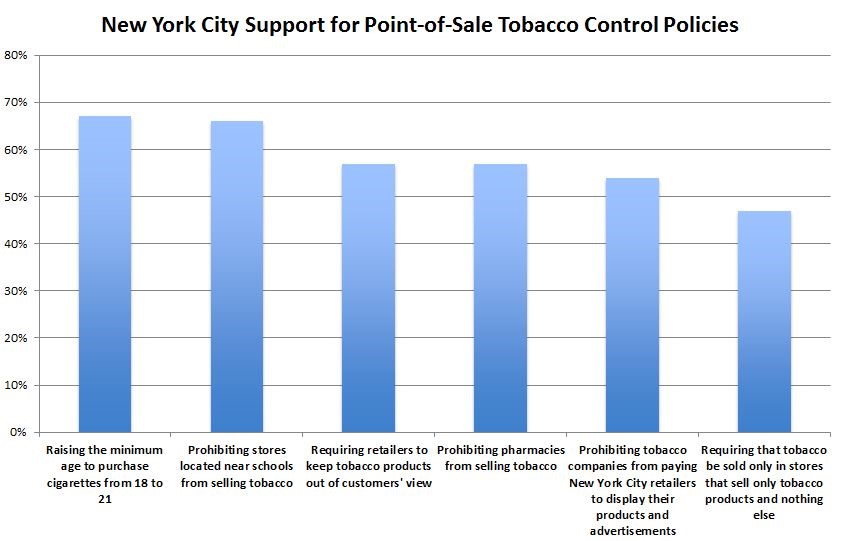Public Opinion Surveys
Why conduct public opinion surveys?
Conducting public opinion surveys is an important part of an overall community assessment and can help your community determine its point-of-sale tobacco control strategy. Public opinion surveys can be used to:
- Measure initial support for tobacco control strategies.
- Determine policies that require education and outreach campaigns to build support (i.e., those with lower levels of public support).
- Assess community norms and assumptions to inform media campaigns and determine policy receptivity in the community [1]
- Help determine how to frame your messaging when educating the community and advocating for the policy.
- Evaluate effectiveness of education and outreach campaigns with follow-up data
- Inform policy priorities. In general, policies with greater support are more likely to pass.
- Provide data to advocate for policy change.
- Evaluate the impact of policies.
How to conduct public opinion surveys
You can craft a public opinion survey specific to point-of-sale issues or you may be able to incorporate measures into existing surveys. When developing a public opinion survey, consider requesting the following information:
- Demographics (e.g., sex, age, race/ethnicity, zipcode). This helps assess the representativeness of your sample.
- Smoking or other tobacco use status
- Support for specific tobacco control policies, such as:
- Prohibiting tobacco retailers near schools
- Limiting the number of tobacco retailers
- Prohibiting price discounts and coupon redemption for tobacco products
- Prohibiting the sale of flavored tobacco products
- Prohibiting the sale of tobacco products in certain types of establishments (e.g. pharmacies)
- Knowledge, attitude, and beliefs about tobacco-related issues
Public opinion surveys can be conducted in a variety of ways, including:
- Phone surveys
- In-person (e.g. public intercept surveys)
- Internet-based surveys
- Mailed surveys
The appropriate format may depend on the sample you are trying to reach, capacity, and time available. This Public Opinion Survey Guidance resource from the University of California Davis’s Tobacco Control Evaluation Center outlines the benefits and drawbacks of each method.
Tobacco control organizations have also had success partnering with a local university or contracting with other entities (e.g. market research firms) to conduct the public opinion research.
Examples of public opinion survey results
- The American public’s opinion of Big Tobacco (2020), Truth Initiative
- In partnership with Campaign for Tobacco Free Kids, Truth Initiative conducted a national survey of registered voters ages 18 and older about their views of the tobacco industry and tobacco use from October 17-28, 2020. A total of 1,583 voters – including 400 African American voters and 400 voters ages 18-24 – were surveyed by cell, landline, and text-to-online.
- The following graph demonstrates data from the 2012 New York City Tobacco Behavior and Public Opinion Survey. In 2013, New York City pursued historic point-of-sale legislation that included some of these policies that had demonstrated high levels of public support—raising the minimum age to purchase cigarettes and a product display ban.

- ANSR MN’s 2015 poll of Saint Paul residents on their support for a proposed ordinance restricting flavored tobacco products to adult-only tobacco shops.
- They found that 64% of city residents supported the proposal.
- This poll was conducted by telephone by Morris Leatherman Company, between November 3-11, 2015. It consisted of 400 randomly selected adult residents of Saint Paul. The poll was commissioned by the Center for Prevention at Blue Cross and Blue Shield of Minnesota, in collaboration with the Association for Nonsmokers-Minnesota.
- Florida’s Voter Opinion Polling (2015)
- Researchers found national broad-based support through a 2013 administration of the Social Climate Survey of Tobacco Control, which demonstrated that over 70% of adults support raising the minimum legal sale age of tobacco products to 21, including the majority of smokers and individuals ages 18-21, who would be most impacted by the law.
Use of public opinion survey results
To learn more about how communities have used public opinion surveys, review the following resources:
- Tobacco-Free Action of Columbia & Green Counties (NY), 2020
- Infographic: Menthol Tobacco: A Pervasive Threat in Minnesota’s African American Community (2016)
- Learn more about the work this survey informed here: Community-led Action to Reduce Menthol Cigarette Use in the African American Community: Menthol Cigarette Intervention Grant Case Study, Minnesota Department of Health
- Understanding Community Norms Surrounding Tobacco Sales (McDaniel & Malone, 2014)
- Public opinions on tax and retail-based tobacco control strategies (Farley et al., 2013)
- The Center for Public Health Systems Science’s Point-of-Sale Community Support Survey: Baseline Assessment for St. Louis County (2011)
Public Opinion Survey Tool Examples
- Data collection instruments database, UC Davis Tobacco Control Evaluation Center
- California Healthy Stores for a Healthy Community Public Intercept Survey (2019)
- Southern Tier Tobacco Awareness Coalition’s Community Tobacco Survey (2021)
Additional Resources
- Evaluation Lifesavers: Resources on Public Opinion Surveys, UC Davis Tobacco Control Evaluation Center
- Public Opinion Survey Guidance, UC Davis Tobacco Control Evaluation Center
- Sampling Decision, UC Davis Tobacco Control Evaluation Center
- Conducting Surveys, Community Toolbox


